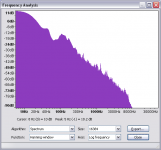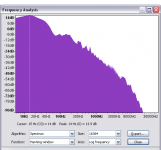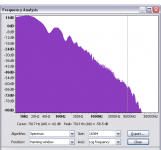Absolutely there is. Human perception is a complex subject and to claim that only double blind test results can be valid is quite an ignorant stance to take.
Although human perception is a complex subject a double-blind test is the only valid test method to acquire meaningful data for the issue we're discussing. If you question this, then we have an epistemological discussion that will not necessarily lead to better sound reproduction.
Best, Markus
OK, regarding Borat's Lady Gaga track:
The LF noise is from the original tracking (recording). It's not present right through the track. Most obviously, it's not present for the first few seconds until the vocals and second synth comes in. There's also a spot at about 1:05 where there is only vocals and synth, where the noise is present, and several short spots later on where it is not present. I would hazard a guess that there are two synth tracks in the mix, and the second one is the one with the LF noise present on it. It's not harmonically related to the music, so it's just plain "rumble". It'll make cones move visibly but not make any effective noise. As for actual musical content, there is nothing below 35 Hz.
For an example of a track where the musical content goes all the way down to 10 or 11 Hz, check out the WaxAudio mashup I mentioned earlier.
For something a little more organic, try "O Varium Fortune", by Corvus Corax, from the "Cantus Buranus II" album. (There are videos on Youtube, but the sound is not good.) As well as huge bass drums about 1.5 metres in diameter, there is a synth sub-bass in the low to mid 20 Hz range that adds real weight to the music.
Or if you have a fairly good home theatre system, one that can do over 120 dB flat down to 15 Hz, go to Audio CD Mastering, Mixing & Replication, navigate to Media --> Downloads --> General. Grab the "Launch At Dawn" video.
And if you have a really good system, one that can do over 125 dB flat down to 5 Hz, open an account and download the 24-bit 96 KHz 4 channel audio-only version, without the music. This is so clean and open that you won't think it very impressive unless your system really is as good as I said. I'm deadly serious - you will not get the full effect unless your system is capable of sucking the breath from your lungs and making the doors to the room flap back and forth by several inches. This is TRW sub territory.
See the attachments for some spectrum analysis samples:
The LF noise is from the original tracking (recording). It's not present right through the track. Most obviously, it's not present for the first few seconds until the vocals and second synth comes in. There's also a spot at about 1:05 where there is only vocals and synth, where the noise is present, and several short spots later on where it is not present. I would hazard a guess that there are two synth tracks in the mix, and the second one is the one with the LF noise present on it. It's not harmonically related to the music, so it's just plain "rumble". It'll make cones move visibly but not make any effective noise. As for actual musical content, there is nothing below 35 Hz.
For an example of a track where the musical content goes all the way down to 10 or 11 Hz, check out the WaxAudio mashup I mentioned earlier.
For something a little more organic, try "O Varium Fortune", by Corvus Corax, from the "Cantus Buranus II" album. (There are videos on Youtube, but the sound is not good.) As well as huge bass drums about 1.5 metres in diameter, there is a synth sub-bass in the low to mid 20 Hz range that adds real weight to the music.
Or if you have a fairly good home theatre system, one that can do over 120 dB flat down to 15 Hz, go to Audio CD Mastering, Mixing & Replication, navigate to Media --> Downloads --> General. Grab the "Launch At Dawn" video.
And if you have a really good system, one that can do over 125 dB flat down to 5 Hz, open an account and download the 24-bit 96 KHz 4 channel audio-only version, without the music. This is so clean and open that you won't think it very impressive unless your system really is as good as I said. I'm deadly serious - you will not get the full effect unless your system is capable of sucking the breath from your lungs and making the doors to the room flap back and forth by several inches. This is TRW sub territory.
See the attachments for some spectrum analysis samples:
Attachments
Moran's own data show that some of the individuals tested, particularly the recording engineers, could discriminate to a statistically significant degree between the signals that received additional CD quality coding and those that bypassed them. I indeed find that conclusive...conclusive that the difference is detectable by many if not all.
What data are you talking about? From the paper "Audibility of a CD-Standard A/D/A Loop Inserted into High-Resolution Audio Playback":
"As the tests progressed, we repeatedly sorted the data
for correlations with age, sex, upper frequency hearing
limit, or experience. No such correlations have emerged.
Specifically, on music at normal levels as defined here,
audiophiles and/or working recording-studio engineers got
246 correct answers in 467 trials, for 52.7% correct. Females
got 18 in 48, for 37.5% correct. Those subjects able
to hear tones above 15 kHz got 116 in 256 trials, for 45.3%
correct; listeners aged 14–25 years old (who were, as it
turned out, the same group), also got 116 correct in 256
trials, 45.3%. The “best” listener score, achieved one
single time, was 8 for 10, still short of the desired 95%
confidence level. There were two 7/10 results. All other
trial totals were worse than 70% correct."
52.7% is significant??
Best, Markus
thoriated, which part of the sentence "Blu-ray discs are now available" is so hard to understand?
Well, Hoo-ray for Blu-Ray. So what?
The “best” listener score, achieved one
single time, was 8 for 10, still short of the desired 95%
confidence level. There were two 7/10 results. All other
trial totals were worse than 70% correct."
Best, Markus
Clearly, insufficient numbers of trials for these listeners to be able to reach any broad brush conclusion disproving the audibility of RBCD coding. I understand there was also criticism that the SACD/DVDA recordings used were insufficient in quality and content to enable the fullest listening discrimination among the test subjects. All in all, it appears enough corners were cut and enough possibilities were ignored in these tests to reach a pre-determined conclusion.
Last edited:
Well, Hoo-ray for Blu-Ray. So what?
You were the one who wanted to make us believe that home theater sound quality is inferior because it has to be AC-3 @ 640 kbit/s. We have proven you wrong. That's all.
Best, Markus
Clearly, insufficient numbers of trials for these listeners to be able to reach any broad brush conclusion disproving the audibility of RBCD coding. I understand there was also criticism that the SACD recordings used were deficient in quality and content to the standard to which discrimination was easily achieved even at lower than RBCD standards.
I quoted just parts from the paper. I doubt that you've ever read it.
"Though our tests failed to substantiate the claimed advantages
of high-resolution encoding for two-channel audio,
one trend became obvious very quickly and held up
throughout our testing: virtually all of the SACD and
DVD-A recordings sounded better than most CDs—
sometimes much better. Had we not “degraded” the sound
to CD quality and blind-tested for audible differences, we
would have been tempted to ascribe this sonic superiority
to the recording processes used to make them."
Please read the paper first otherwise discussing the results makes no sense.
Best, Markus
Last edited:
Although human perception is a complex subject a double-blind test is the only valid test method to acquire meaningful data for the issue we're discussing. If you question this, then we have an epistemological discussion that will not necessarily lead to better sound reproduction.
Best, Markus
Something being your only choice doesn't make it a good one. I'd rather drink nothing than strychnine, if that was the only beverage available.
You were the one who wanted to make us believe that home theater sound quality is inferior because it has to be AC-3 @ 640 kbit/s. We have proven you wrong. That's all.
Best, Markus
No, you are doubly wrong: first for implying that the predominance of AC-3 coding does not lead to degraded HT sound quality when either no other option exists on the disc and/or the playback system cannot decode any higher resolution format (which means in aggregate, most people spinning DVDs will hear only the AC-3 audio) and secondly for saying that I claimed that AC-3 is the only available digital HT audio standard.
Since I never posted such a thing and thus no cite can be given that I did, I'll preemptively accept your concession that you basically just had a flareup of 'hoof in mouth' disease.
Something being your only choice doesn't make it a good one. I'd rather drink nothing than strychnine, if that was the only beverage available.
That analogy makes no sense to me. Do you know of any test method that is more objective than a double-blind test?
Good reading: Audio Musings by Sean Olive: The Dishonesty of Sighted Listening Tests
Best, Markus
I quite liked the linked article at the end, an exemplar of why I think Gordon Holt was the last honest and competent reviewer.
It's too bad that Olive didn't have access to the Supermen of this site who have overcome all human tendencies toward conscious and unconscious bias, can't fool themselves, and thus have no need of controlled subjective testing.
It's too bad that Olive didn't have access to the Supermen of this site who have overcome all human tendencies toward conscious and unconscious bias, can't fool themselves, and thus have no need of controlled subjective testing.
No, you are doubly wrong: first for implying that the predominance of AC-3 coding does not lead to degraded HT sound quality when either no other option exists on the disc and/or the playback system cannot decode any higher resolution format (which means in aggregate, most people spinning DVDs will hear only the AC-3 audio) and secondly for saying that I claimed that AC-3 is the only available digital HT audio standard.
Since I never posted such a thing and thus no cite can be given that I did, I'll preemptively accept your concession that you basically just had a flareup of 'hoof in mouth' disease.
No need to get rude.
I never said or implied that AC-3 coding does not lead to degraded sound quality. I said the opposite.
You claimed that home theater is not about high quality. To refresh your mind please reread your own post.
Can we please stop this type of discussion and stick to the facts? It eats up too much of my time if I have to repeat everything what you and I said just because you can't remember anymore.
Best, Markus
Last edited:
As with much from Olive and the Harman Lab, terrific and exemplary protocols 100% relevant to the show room floor but for extended home listening? The usual unspoken assumption when these studies are quotes is the short term visual distortion is permanent and that preference wouldn't change with long term exposure to these products.
It's too bad that Olive didn't have access to the Supermen of this site who have overcome all human tendencies toward conscious and unconscious bias, can't fool themselves, and thus have no need of controlled subjective testing.
Who are you talking about? Nobody claimed that. The article shows that there will never be any subjective listening test that is free of conscious or unconscious bias as far as possible unless it's done as a double-blind test.
Best, Markus
That analogy makes no sense to me. Do you know of any test method that is more objective than a double-blind test?
Good reading: Audio Musings by Sean Olive: The Dishonesty of Sighted Listening Tests
Best, Markus
Blind testers always claim to train people, how do they establish the right way to train people? Differences about culture of real persons can be rather huge. They can just introduce their standard. Should we buy Harman products or products that are in line with their standard only? No thanks.
There is just one standard for me: live music. That's my training!
Last edited:
Markus, sorry, I know that American English is funny that way (und deine Englisch ist vielmals besser als meine Deutsch)- I was being sarcastic. There are no Audio Supermen, just sad people who cannot comprehend their own humanity.
I still haven't gotten a good answer to the question, "What sonic insights do you get from peeking?" But that's no doubt because I hate music, I don't listen, my system is crappy, and I'm deaf as a post.
I still haven't gotten a good answer to the question, "What sonic insights do you get from peeking?" But that's no doubt because I hate music, I don't listen, my system is crappy, and I'm deaf as a post.
Those studies are not conclusive but this one is:
AES E-Library: Audibility of a CD-Standard A/DA/A Loop Inserted into High-Resolution Audio Playback
Furthermore, if 44.1kHz/16bit would lead to bad sound then an additional 44.1kHz/16bit A/D/A would sound even worse, right? The double-blind test showed that this is not true.
Best, Markus
No, it's not "conclusive". It's something to bear in mind. There was a discussion thread on DIYaudio a year or so ago about Meyer et al article.
http://www.diyaudio.com/forums/everything-else/128488-aes-objective-subjective-forum-2.html
The room the playback equipment and speakers are all questionable. This was the set up. Your room and speakers are better than this.
BAS Experiment Explanation page - Oct 2007

That setup could allow for quite bit of diffraction and other linear distortion. Linear distortion is often a problem with digital playback, so it's possible that what difference that may have been audible was masked.
Kunchur points out to us that when equipment variables are eliminated we can hear differences as small as 6 microseconds and that the ability to discriminate is not age dependent as discrimination of frequency is.
In the third paper listed in which speakers were used rather than filters Kunchur talks about the room treatment used which was adequate but not extreme and certainly not unrealistic.
So, Meyer's study is something to keep in mind, is suggestive, but is far from "conclusive".
But that's no doubt because I hate music, I don't listen, my system is crappy, and I'm deaf as a post.
You forgot furry.
1. It all depends on the application required.
2. Its less about driver choices and more about the speaker design itself that makes for an incredible speaker.
Hi Doug
I so overwhelmingly agree with your second point that I believe that it makes the first one irrelavent.
- Status
- Not open for further replies.
- Home
- Loudspeakers
- Multi-Way
- Pro vs hifi drivers - pros and cons?


